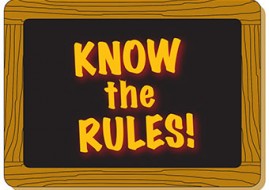ABA Studies ‘Super,’ ‘Best,’ and Other Lawyer Rankings (Part I)
By Roy Simon [Originally published in NYPRR June 2011]
The American Bar Association Commission on Ethics 20/20 is studying law firm rankings. Last year, the ABA House of Delegates approved a resolution stating: “Resolved, that the American Bar Association examine any efforts to publish national, state, territorial, and local rankings of law firms and law schools.” Carolyn Lamm, then the ABA President, asked the ABA Commission on Ethics 20/20 to examine the issue of lawyer and law firm ratings and rankings. (In addition, a special committee of the ABA Section of Legal Education and Admissions to the Bar was created to study law school rankings, which are a separate subject.) In April 2011, the Ethics 20/20 Commission released a “draft Informational Report” about rankings of lawyers and firms. My article this month will examine the background of the ranking issue. Next month (July 2011), in Part II, I will discuss the contents of the Informational Report.
Background: How and When Did Lawyer Rankings Begin?
To put the issue of lawyer and law firm rankings in historical context, I will review how it all got started, at least in the modern era.
The forerunner of Martindale-Hubbell was first published in 1868. The stated purpose of The Martindale Directory (as it was then called) was “to furnish to lawyers, bankers, wholesale merchants, manufacturers, real estate agents, and all others…the address of one reliable law firm, one reliable bank, and one reliable real estate office in every city in the united States…” In 1930, Martindale purchased the rights to Hubbell’s Legal Directory, and in 1931 the combined company published the first edition of the Martindale-Hubbell Law Directory. Those thick, dry volumes, which decorated a lawyer’s bookshelves, were used almost exclusively by corporate clients and lawyers looking for lawyers in a given geographic location or a given field of law. Martindale-Hubbell gave its strange AV, BV, and CV ratings to lawyers based on peer reviews, but few people thought of these bland ratings as crass advertising or as lawyer “rankings.”
In 1977, as we know, the United States Supreme Court radically changed the legal profession by holding, in Bates v. State Bar of Arizona, 433 U.S. 350 (1977), that lawyers had the right under the First Amendment to advertise truthful, non-misleading information about themselves. In arriving at this holding, the majority said: “Since the belief that lawyers are somehow ‘above’ trade has become an anachronism, the historical foundation for the advertising restraint has crumbled.”
Two years after Bates, in 1979, Steve Brill founded The American Lawyer. The innovative AmLaw 100 Survey ranked law firms by size, revenue, and the talismanic number “profits per partner.” Suddenly, the secret financial business of Wall Street firms was public. In addition, The American Lawyer bestowed awards such as “Litigator of the Year” and “Dealmaker of the Year.” Bates and Brill had ushered in the modern era.
Entrepreneurs Get into the Ranking Business
The next major turning point was the realization by various entrepreneurs that ranking lawyers and law firms could be a lucrative business. Best Lawyers of America, one of the highest profile players in the lawyer-ranking field, published its first edition in 1983. According to its own website, Best Lawyers “compiles lists of outstanding attorneys by conducting exhaustive peer-review surveys in which thousands of leading lawyers confidentially evaluate their professional peers.” The result is The Best Lawyers in America. The latest edition includes 41,149 attorneys (approximately 6% of all American lawyers) in 126 practice areas, covering all 50 states, in D.C., and in many foreign countries. The Best Lawyers website claims that the 17th edition of The Best Lawyers in America (2011) “is based on more than 3.1 million detailed evaluations of lawyers by other lawyers.” and who reads these evaluations? “Internationally,” Best Lawyers claims, “more than 200,000 individuals, 1,800 law firms, and 4,500 general counsel subscribe to BestLawyers.com.” That’s a lot of eyeballs.
An even more aggressive provider is Super Lawyers. According to my research assistant (Wikipedia), Super Lawyers began in 1991 as a special section of a Minnesota political magazine. It grew slowly. It took six years, until 1997, before a Super Lawyers insert appeared in a paper in lawyer-dense Washington, D.C., and six more years, until 2003, before the publication of Texas Super Lawyers. Then the afterburners kicked in (or something). Today, Super Lawyers publishes in all 50 states and D.C., and publishes special advertising sections in regional magazines and newspapers. In 2008, the company began publishing Super Lawyers— Corporate Counsel edition, which was distributed to 25,000 in-house lawyers and CEOs across the country.
Chambers and Partners, a British firm, which began researching the U.S. legal profession in 1999, employs100 fulltime researchers who conduct interviews with lawyers and clients worldwide. Chambers then ranks lawyers and law firms in bands from 1 to 6. “According to the criteria most valued by clients — such as technical expertise, business acumen, prompt delivery, value for money,” the website says. Chambers also holds award ceremonies to “honor outstanding practitioners around the world.”
A lesser known but fast growing company is Lawdragon, which solicits reviews of lawyers from clients, peers and jurors, then bases its rankings on these reviews and its own research. The website says: “anyone with information about a lawyer or judge can submit an evaluation at Lawdragon.com.” The Lawdragon rankings range from ‘no ranking’ (given to lawyers who have not received the minimum number of evaluations) to the Lawdragon 500, its superior ranking.
Avvo.com, which began in 2007, is oriented toward individual rather than corporate clients. The site invites users to browse for lawyers in areas such as Bankruptcy, Landlord/Tenant, Estate Planning, Personal Injury, Criminal Defense, and Speeding/Traffic Ticket. Avvo uses a secret proprietary formula to rate lawyers from 1 to 10. The site includes client reviews, disciplinary actions, and peer endorsements, and allows lawyers to augment their listings by submitting their own information. The site makes money by charging lawyers to advertise on the website.
There are also websites like www.toplawyersofAmerica.com that, despite their name, do not appear to make any effort at all to rank or even evaluate lawyers — they are simply advertising sites that have figured out how to make their sites show up when you search for the best lawyers in America.
Law firms happily advertise that their lawyers are listed in Super Lawyers and Best Lawyers — and sometimes rank themselves based on how many of their lawyers make the cut. For example, my other research assistant (Google) tracked down this item from the Vinson & Elkins site: “The Best Lawyers in America® 2010 lists 168 V&E lawyers in its newest guide and lists more V&E lawyers nationally than any other firm in two areas of law: Energy and International Trade and Finance.”
Lawyers also rank the rankings services. A family law sole practitioner in Philadelphia who is listed in the 2010 edition of Best Lawyers in America says on his website, right next to the logo for Best Lawyers: “For over a quarter century,” Best Lawyers® has been regarded — by both the profession and the public — as the definitive guide to legal excellence in the United States… Because no fee or purchase is required, being listed in Best Lawyers is considered a singular honor.” And of course the ranking services also tout their own wares — at least in the phrase that pops up when you do a Google search for “top ranking lawyers.” The fairly staid Lawyers.com, for example, pops up on Google saying: “Use the #1 Online Lawyer Directory.”
Super Lawyers and Best Lawyers Come Under Fire in New Jersey
Every lawyer may secretly want to be called a Super Lawyer, but not everyone wants the competition to be called Super Lawyers. As Super Lawyers gained visibility and generated an increasing amount of buzz, some lawyers in New Jersey converted their discomfort over rankings into bar complaints. In May 2005, a New Jersey lawyer sent the New Jersey Committee on attorney advertising a magazine titled “New Jersey Super Lawyers.” The lawyer said the magazine was designed to be circulated among clients and potential clients in order to create the impression that the attorneys designated “Super Lawyers” are more qualified than other attorneys in the State. The complainant also asserted that the process of being designated and advertised as a “Super Lawyer” violated various sections of the New Jersey rules of Professional Conduct. In January 2006, another New Jersey lawyer filed a grievance complaining about correspondence he had received from another New Jersey law firm touting the inclusion of several of its members among “The Best Lawyers in America for 2005.” New Jersey’s Committee on attorney advertising, which is appointed by the new Jersey Supreme Court, formally addressed those complaints in its Opinion 39 (2006). The Committee said:
The issue is whether advertisements in any medium of distribution publicizing certain New Jersey lawyers as “Super Lawyers” or “Best Lawyers in America” violate the prohibition against advertisements that are comparative in nature … or that are likely to create an unjustified expectation about results …
In an opinion that was not long on reasoning (the entire opinion was only 3 pages), the Committee concluded that such advertisements were “prohibited by the rules of Professional Conduct.” But Super Lawyers and Best Lawyers appealed. Since this was a test case that would have national impact, both publications threw a lot of resources into the appeal, hiring professional responsibility expert Bennett Wasserman and former Third Circuit Judge John Gibbons to handle the appellate work. The New Jersey Supreme Court took the matter seriously as well, referring it to a truly special Special master, retired new Jersey Appellate Division Judge Robert Fall “for the limited purpose of developing an evidentiary record in respect of the facts and legal issues that relate to the petitions for review.” The parties submitted extensive briefs and presented piles of documentary evidence. On June 18, 2008, after considering the “voluminous record,” the Special Master issued a 304-page report. The New Jersey Supreme Court described the key language in the report as follows:
[T]he report warned that state bans on truthful, fact-based claims in professional advertising could be ruled unconstitutional when the state fails to establish that the regulated claims are actually or inherently misleading. The report concluded that those states that have addressed the same issues have permitted comparative and quality-of-services advertising, usually construing such advertising to be an implied comparison, but finding there is a subjective or objective basis for the comparison that can be verified by disclosure and an analysis of the underlying peer-review rating methodology.
In a thoughtful 26-page opinion issued in mid-December 2008, the New Jersey Supreme Court agreed with the Special Master’s approach and vacated the Advertising Committee’s Opinion 39.
Meanwhile, Back in New York …
While all of the hullabaloo over Super Lawyers and Best Lawyers was going on in New Jersey, lawyers in New York were developing and debating amendments to the Disciplinary Rules that governed lawyer advertising. In 2005, in one of his first acts as State Bar President for 2005–06, Rochester lawyer Vince Buzard appointed a Task Force on Lawyer Advertising, which worked diligently and issued a huge data-rich report in the Fall 2005. At the same time, but secretly, the Appellate Divisions — egged on by Fourth Department Presiding Justice Eugene Pigott of Rochester (now on the Court of Appeals) — began developing its own proposed rules to clamp down on attorney advertising.
In June 2006, a month before the New Jersey Committee on attorney advertising issued Opinion 39, the New York Courts issued a proposed set of Byzantine and draconian advertising rules for public comment. One of the sticking points in refining those proposals over the next few months was the problem of lawyer and law firm ratings and rankings. Given that Super Lawyers and Best Lawyers had already launched their powerful appeal in New Jersey, they would be in a solid position to challenge New York’s new rules on First amendment grounds. The same First Amendment arguments that had been made in New Jersey could also be made in New York.
Somewhere behind closed doors, the issue of ratings and rankings was “negotiated” (or so I heard). When the New York Courts finally adopted amended advertising rules effective Feb. 1, 2007, DR 2-101(B)(1) expressly permitted lawyers to advertise “bona fide professional ratings” as long as they were not “false, deceptive or misleading.” The provision allowing lawyers to advertise bona fide professional ratings had not been in the 2006 proposals.
The day after the new advertising rules took effect, the upstate personal injury firm of Alexander & Catalano (“The Heavy Hitters”) and the non-profit Public Citizen, Inc. challenged a number of the more stringent provisions, and in July 2007 the Northern District of New York, per Judge Scullin, declared most of the challenged advertising provisions unconstitutional and issued a permanent injunction against their enforcement. Nearly three years later, in an opinion by former Yale Law School Dean Judge Guido Calabrese, the Second Circuit affirmed nearly the entire district court opinion. In December 2010, the United States Supreme Court denied New York’s petition for certiorari. [See Alexander v. Cahill, 2007 WL 2120024 (N.D.Y.Y. 2007), aff’d in part and modified in part, 598 F.3d 79 (2d Cir.), cert. denied, 131 U.S. 820 (2010).] A lot of lawyer time and a lot of taxpayer money had been wasted in New York’s hopeless effort to defend advertising rules that many observers thought were unconstitutional before they were even formally issued, but at least Rule 7.1’s express permission to advertise bona fide professional ratings had avoided a costly and time-consuming constitutional fight about that issue.
In November 2007, the New York State Bar Association House of Delegates approved a set of Ethical Considerations to explain the new advertising rules. One of the new ECs was EC 2-11, entitled “Bona Fide Professional ratings.” The language of DR 2-101(B)(1) and EC 2-11 survives today verbatim in rule 7.1(b)(1) (which continues to permit “bona fide professional ratings”) and in Comment [13] to Rule 7.1, which provides as follows:
Bona Fide Professional Ratings
[13] An advertisement may include information regarding bona fide professional ratings by referring to the rating service and how it has rated the lawyer, provided that the advertisement contains the “past results” disclaimer as required under paragraphs (d) and (e). However, a rating is not “bona fide” unless it is unbiased and nondiscriminatory. Thus, it must evaluate lawyers based on objective criteria or legitimate peer review in a manner unbiased by the rating service’s economic interests (such as payment to the rating service by the rated lawyer) and not subject to improper influence by lawyers who are being evaluated. Further, the rating service must fairly consider all lawyers within the pool of those who are purported to be covered. For example, a rating service that purports to evaluate all lawyers practicing in a particular geographic area or in a particular area of practice or of a particular age must apply its criteria to all lawyers within that geographic area, practice area, or age group.
Next month, I will explain how the ABA got dragged into the debate over lawyer and law firm rankings, and I will discuss in detail the Informational Report issued in late April 2011by the ABA Commission on Ethics 20/20.
Professor Roy Simon is the author of Simon’s New York Rules of Professional Conduct Annotated. The brand new 2015 edition analyzes more than 100 new cases, ethics opinions, and other developments critical to New York practice. It’s the legal ethics bible for all New York-area lawyers. To purchase, click here.
In addition, Professor Simon advises lawyers and law firms on questions of professional conduct and serves as an expert witness in cases raising issues of lawyer conduct. You may reach Professor Simon at 516-463-5289 or Roy.Simon@hofstra.edu.
Further Reading — NYPRR Coverage of Lawyer Rankings
In the period (2006–07) leading up to the new interest by the ABA 20/20 Commission and others in lawyer rankings like SuperLawyer and Best Lawyer, NYPRR published several articles about the rankings. This was the period that led to the decision in Alexander v. Cahill.
♦ NYPRR September 2006: The Second Battle of Trenton: The Super and the Best
♦ NYPRR February 2007: Commentary: Questions Persist on Issue of Lawyer Ratings
♦ NYPRR November 2007: Litigation over Lawyer Ratings Continues in NY and NJ
DISCLAIMER: This article provides general coverage of its subject area and is presented to the reader for informational purposes only with the understanding that the laws governing legal ethics and professional responsibility are always changing. The information in this article is not a substitute for legal advice and may not be suitable in a particular situation. Consult your attorney for legal advice. New York Legal Ethics Reporter provides this article with the understanding that neither New York Legal Ethics Reporter LLC, nor Frankfurt Kurnit Klein & Selz, nor Hofstra University, nor their representatives, nor any of the authors are engaged herein in rendering legal advice. New York Legal Ethics Reporter LLC, Frankfurt Kurnit Klein & Selz, Hofstra University, their representatives, and the authors shall not be liable for any damages resulting from any error, inaccuracy, or omission.
Related Posts
« What’s in a Name? More than Meets the Eye Courts Prepare for a Major Disaster »








